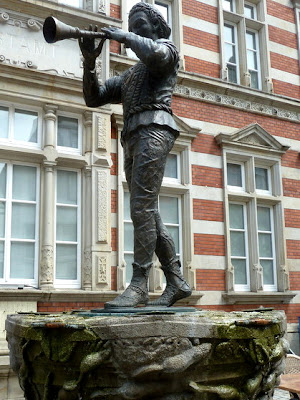Henry´s Lion on his plinth takes centre stage.
Preparations are now well under way for the opening performance of "La Traviata" on the 8th August. I took this photo of Henry's Lion just before a kindly sound engineer told me to wander around, and see some even better kissing lions on the other side of the stage. He spoke excellent English, and works all around the world setting up the sound systems for concerts and open air theatres. English seems to the the common language in all countries. What an interesting job! The director of this production of "La Traviata" is an Englishman, and he is very good too, so my informant told me.
Parts of the scenery, two kissing lions and two gravestones.
I am going to a performance, and it will be interesting to see exactly where these lions are positioned and what part they play in the action. Very soon the rehearsals will begin, and on a warm afternoon it is pleasant to sit on the lion benches outside the cathedral, and listen to the chorus and soloists practising their parts. The orchestra plays too, and this part of BS is filled with wonderful music every day.
I am going to a performance, and it will be interesting to see exactly where these lions are positioned and what part they play in the action. Very soon the rehearsals will begin, and on a warm afternoon it is pleasant to sit on the lion benches outside the cathedral, and listen to the chorus and soloists practising their parts. The orchestra plays too, and this part of BS is filled with wonderful music every day.
More parts of the scenery and the pink boxes containing the sound equipment and cables.
The Landesmuseum to the left, and the little ticket kiosk in the centre.
A similar scene, with the cathedral to the right, and the open air stage occupying the whole Burgplatz.
There are many benches along this side of the cathedral, a good spot for listening to free music by Verdi. The beautiful face of "The Lady of the Camillias" can be seen on the posters.
There are many benches along this side of the cathedral, a good spot for listening to free music by Verdi. The beautiful face of "The Lady of the Camillias" can be seen on the posters.





















































.JPG)